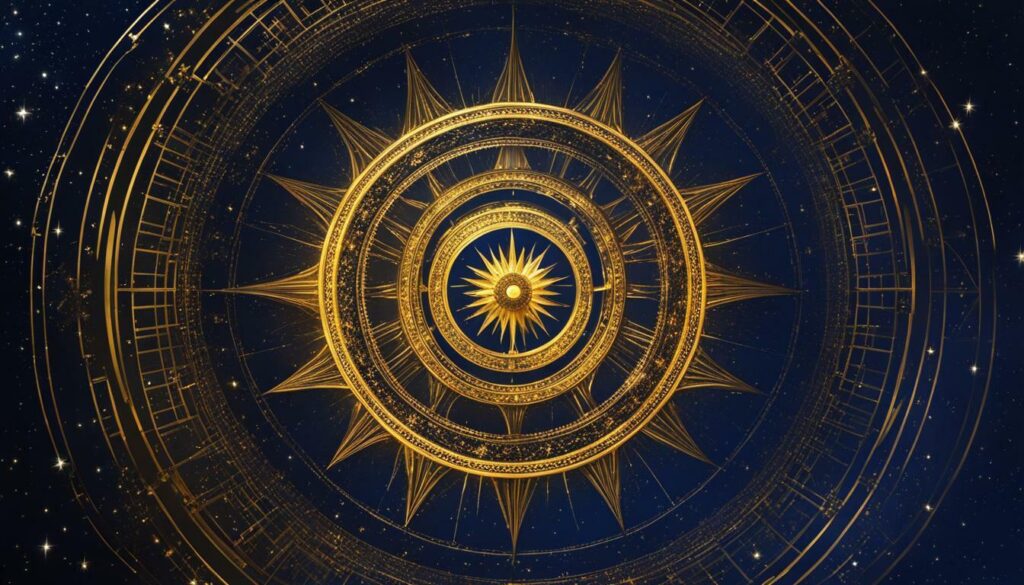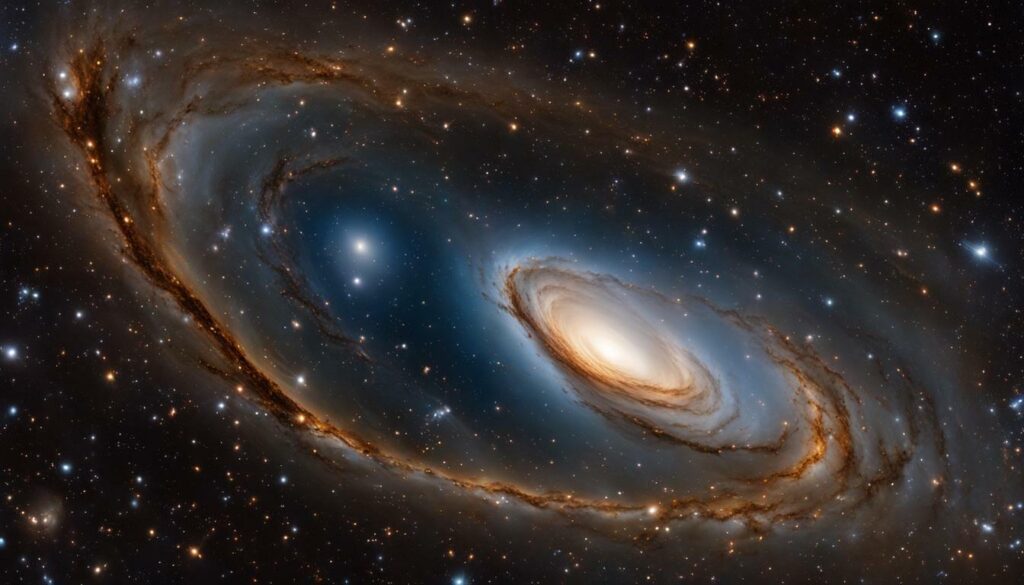Welcome to the fascinating world of astrology, where we explore the question, “What is the first largest zodiac sign?”. Astrology has intrigued and captivated humanity for centuries, offering insights into our personalities, relationships, and destinies based on the alignment of celestial bodies at the time of our birth.
Key Takeaways:
- Virgo is the first largest zodiac sign and the second-largest constellation in the sky.
- It is visible in the Northern Hemisphere during spring and summer, and in the Southern Hemisphere during autumn and winter.
- Virgo is home to Spica, one of the brightest stars, and the Virgo cluster, an amalgamation of over 1,300 galaxies.
- It is also known for its 11 Messier objects, including galaxies like Messier 49, Messier 58, and the Butterfly Galaxies (NGC 4567 and NGC 4568).
As we delve deeper into the world of astrology, we will uncover the meanings and characteristics associated with each zodiac sign. Join us on this journey to gain a better understanding of the first largest zodiac sign, Virgo, and how it influences our lives.
Understanding Zodiac Signs and Their Meanings
Before we uncover the first largest zodiac sign, let’s first understand the meanings and characteristics assigned to each zodiac sign. Astrology, an ancient practice rooted in celestial observations, associates specific traits and qualities with each of the twelve zodiac signs. These signs are determined by the position of the sun at the time of your birth and are believed to influence different aspects of your personality and life.
The zodiac signs are generally divided into four elements: fire, earth, air, and water. Fire signs (Aries, Leo, and Sagittarius) are known for their passion, enthusiasm, and leadership qualities. Earth signs (Taurus, Virgo, and Capricorn) are practical, reliable, and grounded. Air signs (Gemini, Libra, and Aquarius) are intellectual, social, and adaptable. Water signs (Cancer, Scorpio, and Pisces) are emotionally intuitive, empathetic, and nurturing.
- Aries (Mar 21 – Apr 19): Aries individuals are known for their boldness, determination, and optimism. They are natural-born leaders with a competitive spirit.
- Taurus (Apr 20 – May 20): Taureans are practical, reliable, and possess a strong sense of loyalty. They value stability, security, and material comforts.
- Gemini (May 21 – Jun 20): Geminis are sociable, versatile, and curious. They possess excellent communication skills and are known for their adaptability.
- Cancer (Jun 21 – Jul 22): Cancerians are deeply intuitive, empathetic, and compassionate. They value family, home, and emotional security.
Each zodiac sign holds unique characteristics that shape your personality, relationships, and life experiences.
These descriptions provide a glimpse into the diverse qualities associated with each zodiac sign. By understanding the meanings and characteristics behind each sign, we can gain insight into ourselves and the people around us. Whether you believe in astrology or not, exploring the zodiac signs can be a fascinating journey of self-discovery.

Unlocking the Secrets of the Zodiac
Delve deeper into the world of astrology by exploring the unique characteristics and tendencies of each zodiac sign. From fiery Aries to sensitive Pisces, the zodiac signs offer a rich tapestry of traits that shape our individuality. By understanding the intricacies of astrology, we can gain valuable insights into ourselves and others, fostering empathy, self-awareness, and personal growth.
Introducing Virgo – The First Largest Zodiac Sign
Allow us to introduce Virgo, the first largest zodiac sign that holds great importance in astrology. Virgo is not only the second-largest constellation in the sky but also the largest constellation of the Zodiac. Positioned between Leo and Libra, Virgo graces the night sky with its celestial presence.
In the Northern Hemisphere, Virgo becomes visible during the spring and summer months, while in the Southern Hemisphere, it can be admired during autumn and winter. Its prominence during these seasons adds to its allure and captivates stargazers around the world.
One of the notable features of Virgo is its brightest star, Spica. This luminous star shines within the constellation, enchanting observers with its brilliance. Spica not only enhances the visual appeal of Virgo but also plays a significant role in shaping the astrological characteristics associated with this zodiac sign.

The Virgo Cluster and its Galaxies
Within the constellation of Virgo lies the awe-inspiring Virgo cluster. Comprised of over 1,300 galaxies, this cosmic amalgamation is a stellar sight to behold. With its vast collection of galaxies, the Virgo cluster showcases the cosmic wonders of the universe and invites us to marvel at its grandeur.
Furthermore, Virgo is home to 11 Messier objects, making it a celestial treasure trove for astronomers and stargazers alike. These objects include notable galaxies such as Messier 49, Messier 58, and the spectacular Butterfly Galaxies, NGC 4567 and NGC 4568. Their presence within Virgo adds to its cosmic richness and offers endless opportunities for exploration and discovery.
As we journey through the cosmos, Virgo stands as a testament to the celestial beauty that surrounds us. Its significance as the first largest zodiac sign in astrology provides us with insight into the intricate universe that we are a part of. So, let us gaze upon the wonders of Virgo and deepen our understanding of the cosmos.
| Zodiac Sign | Size |
|---|---|
| VIRGO | First Largest |
| LIBRA | Second Largest |
| SCORPIO | Third Largest |
Virgo’s Position in the Night Sky
Whether you’re in the Northern or Southern Hemisphere, Virgo’s constellation can be spotted during specific seasons in the night sky. In the Northern Hemisphere, Virgo is visible from spring to summer, while in the Southern Hemisphere, it can be seen during autumn and winter. This means that depending on where you are, you can catch a glimpse of this prominent zodiac sign at different times of the year.
With its position between the constellations Leo and Libra, Virgo holds a special place in the celestial realm. Its unique pattern of stars makes it stand out, and it is the second-largest constellation in the sky, as well as the largest constellation of the Zodiac. Within Virgo, one of the brightest stars is Spica, which adds to the allure of this constellation.

Virgo’s constellation stretches across the sky, creating a captivating image that has intrigued astronomers and stargazers alike. Its presence in the night sky is a testament to the beauty and mystery of the cosmos. With its distinct shape and identifiable stars, Virgo serves as a guidepost for those seeking to connect with the wonders of the universe.
The Marvels of Virgo
Virgo’s positioning in the night sky not only offers a visual spectacle but also reveals an abundance of cosmic treasures. Within the constellation lies the Virgo cluster, a colossal aggregation of over 1,300 galaxies. This cluster astounds astronomers with its vastness and serves as a reminder of the vastness of our universe.
In addition to the Virgo cluster, this constellation is home to numerous Messier objects. These objects, cataloged by astronomer Charles Messier, include galaxies such as Messier 49, Messier 58, and the Butterfly Galaxies (NGC 4567 and NGC 4568). These captivating celestial entities add to the allure and richness of Virgo, captivating the imagination of astronomers and stargazers alike.
| Virgo’s Position in the Night Sky | Notable Features |
|---|---|
| Visible during specific seasons in the Northern Hemisphere | Spica – one of the brightest stars in the constellation |
| Visible during specific seasons in the Southern Hemisphere | Virgo cluster – a large amalgamation of over 1,300 galaxies |
| Messier objects, including galaxies like Messier 49, Messier 58, and the Butterfly Galaxies (NGC 4567 and NGC 4568) |
Virgo’s Bright Star – Spica
At the heart of Virgo lies a brilliant star called Spica, whose radiance adds to the allure of this zodiac sign. This celestial beauty shines as one of the brightest stars in the night sky, captivating stargazers and astrologers alike. Spica is a binary star system, comprised of two stars orbiting each other, and it resides at a distance of about 260 light-years from Earth.
Spica’s name originates from the Latin word meaning “ear of grain,” reflecting its association with the Virgo constellation, often symbolized by a maiden holding a sheaf of wheat. This connection between Spica and Virgo highlights the sign’s qualities of fertility, abundance, and nurturing. Astrologically, Spica embodies the essence of Virgo, known for its practicality, attention to detail, and analytical nature.
| Interesting Facts about Spica: |
|---|
| 1. Spica is approximately 2,200 times more luminous than our Sun, making it a prominent feature in the night sky. |
| 2. It is estimated that Spica’s combined mass is around 10 times greater than that of the Sun. |
| 3. Spica is classified as a blue giant star, with a surface temperature of over 22,000 degrees Celsius. |
| 4. The Spica binary system completes one orbit in approximately 4 days. |
As we gaze upon the brilliance of Spica, we are reminded of the profound connection between the celestial realm and our earthly existence. This star serves as a guiding light, illuminating the path for those born under the zodiac sign of Virgo, and inspiring us to embrace the qualities and virtues that define this remarkable constellation.

References:
- EarthSky. (n.d.). The Star Spica. Retrieved from https://earthsky.org/brightest-stars/spica-brilliant-button-on-virgos-garment
- NASA. (n.d.). Spica: Brightest Star in Virgo. Retrieved from https://exoplanets.nasa.gov/resources/136/spica-brightest-star-in-virgo/
The Virgo Cluster and its Galaxies
Beyond individual stars, Virgo is home to the impressive Virgo cluster, housing over 1,300 galaxies within its cosmic boundaries. This vast amalgamation of galaxies, located within the Virgo constellation, is a sight to behold for astronomers and stargazers alike. Spanning across millions of light-years, the Virgo cluster offers a glimpse into the cosmic wonders of our universe.

Within the Virgo cluster, astronomers have identified several notable galaxies. One such galaxy is Messier 49, an elliptical galaxy known for its dense central region and a vast system of globular clusters. It is a centerpiece of the Virgo cluster and provides insights into the formation and evolution of galaxies.
Another notable galaxy within the Virgo cluster is Messier 58, a barred spiral galaxy that showcases beautiful spiral arms and a bright central region. This galaxy serves as a platform for studying the processes of star formation and the dynamics of galactic evolution.
The Butterfly Galaxies, also known as NGC 4567 and NGC 4568, are a pair of interacting spiral galaxies within the Virgo cluster. These galaxies are named for their distinctive shape, resembling the delicate wings of a butterfly. Their interaction provides astronomers with valuable insights into the phenomenon of galaxy mergers and the resulting effects on star formation and evolution.
Virgo Cluster Galaxies
| Galaxy | Classification |
|---|---|
| Messier 49 | Elliptical galaxy |
| Messier 58 | Barred spiral galaxy |
| Butterfly Galaxies | Interacting spiral galaxies |
The Virgo cluster and its galaxies offer a rich tapestry of celestial wonders for astronomers to explore. From the grandeur of elliptical galaxies to the intricate beauty of spirals in motion, Virgo provides a captivating glimpse into the vastness and complexity of our universe.
Messier Objects in Virgo
Within the constellation of Virgo, astronomers have identified several captivating Messier objects, including Messier 49, Messier 58, and the mesmerizing Butterfly Galaxies. These objects showcase the celestial wonders found within this expansive zodiac sign, providing astronomers and stargazers alike with glimpses into the vastness of the universe.
One notable Messier object in Virgo is Messier 49, a giant elliptical galaxy located approximately 55 million light-years away. With a diameter of around 160,000 light-years, this galaxy is among the largest in the Virgo cluster. Messier 49 is known for its dense central region, containing billions of stars dancing amidst a cosmic symphony.
Another intriguing object within Virgo is Messier 58, a spiral galaxy located around 68 million light-years away. This galaxy possesses a unique characteristic known as a “bar,” which extends through its core. The bar shape is formed by a concentration of stars, gas, and dust, contributing to the mesmerizing visual spectacle of Messier 58.
In the realm of the Butterfly Galaxies, we find NGC 4567 and NGC 4568. These twin galaxies are interacting, with their gravitational forces intertwining and shaping their appearance. The cosmic dance between NGC 4567 and NGC 4568 creates an exquisite sight, resembling the graceful fluttering of butterfly wings across the canvas of the night sky.
| Messier Object | Description |
|---|---|
| Messier 49 | A giant elliptical galaxy located 55 million light-years away. |
| Messier 58 | A spiral galaxy located 68 million light-years away, featuring a distinctive bar shape. |
| Butterfly Galaxies (NGC 4567 and NGC 4568) | Interacting twin galaxies, creating a visually captivating butterfly-like appearance. |
As we explore the depths of the Virgo constellation, we uncover these remarkable Messier objects, each with its own story and allure. These celestial marvels remind us of the endless wonders awaiting discovery, inviting us to gaze upon the cosmos with awe and curiosity.

Exploring Zodiac Compatibility with Virgo
Virgo’s astrological personality intertwines with other zodiac signs to create unique dynamics in various relationships. When it comes to compatibility, Virgos are known for their practicality, attention to detail, and analytical nature. These traits often influence the dynamics and interactions with other signs, shaping the overall compatibility.
In relationships, Virgo individuals are often drawn to signs that share their values of loyalty, honesty, and hard work. They are most compatible with Taurus and Capricorn, forming strong bonds based on mutual understanding and similar goals. The earthy nature of these signs complements Virgo’s grounded approach to life.
On the other hand, Virgos may face challenges in relationships with signs that differ in their approach and priorities. The spontaneous and adventurous nature of signs like Aries and Sagittarius can clash with Virgo’s need for structure and order. However, this doesn’t mean that these relationships are doomed; with open communication and understanding, Virgos can find balance and harmony with these signs.
Virgo Compatibility Chart
| Zodiac Sign | Compatibility Rating |
|---|---|
| Taurus | High |
| Capricorn | High |
| Cancer | Medium |
| Scorpio | Medium |
| Pisces | Medium |
| Leo | Low |
| Aquarius | Low |
| Aries | Low |
Remember, compatibility is not solely determined by sun signs but also influenced by other factors such as moon signs, rising signs, and the overall astrological makeup of individuals. It’s important to consider the complete birth chart for making accurate compatibility assessments.
As the first largest zodiac sign, Virgo brings its own unique qualities and perspectives to relationships. Its meticulous and organized nature can bring stability and practicality to partnerships. By understanding the compatibility between Virgo and other signs, individuals can navigate relationships more effectively and foster deeper connections.

Unveiling Horoscope Insights for Virgo
If you’re a Virgo, your horoscope holds valuable insights and advice to navigate life’s twists and turns. This earth sign, represented by the Virgin, is known for its practicality, attention to detail, and analytical nature. Your horoscope can provide guidance on various aspects of your life, including relationships, career, and personal growth.
In matters of the heart, Virgos are known for their loyalty and commitment. Your horoscope can shed light on your compatibility with other signs, helping you understand the dynamics of your relationships. Whether you’re seeking a stable partnership or striving to improve an existing one, your horoscope can offer valuable insights into communication styles, emotional needs, and areas of compatibility.
“Virgos are known for their practicality, attention to detail, and analytical nature.”
Career-wise, horoscopes for Virgo individuals can provide guidance on finding fulfillment in your professional life. With your meticulous nature and keen eye for detail, you excel in roles that require precision and organization. Your horoscope can offer advice on harnessing your strengths, navigating office politics, and seizing opportunities for growth and success.
On a personal level, your horoscope can provide guidance on self-care, personal development, and overall well-being. As a Virgo, you may be prone to overthinking and self-criticism. Your horoscope can offer insights into managing stress, cultivating self-compassion, and embracing a balanced lifestyle.

Virgo Horoscope for [Current Month]
| Date | General Forecast | Love and Relationships | Career and Finance |
|---|---|---|---|
| [Date] | [General Forecast for the day] | [Love and Relationship Forecast for the day] | [Career and Finance Forecast for the day] |
| [Date] | [General Forecast for the day] | [Love and Relationship Forecast for the day] | [Career and Finance Forecast for the day] |
Stay connected with your horoscope to gain valuable insights, seek guidance, and embrace the opportunities that come your way. Remember, your horoscope is a tool for self-reflection, personal growth, and making informed decisions.
Conclusion
In conclusion, delving into the world of astrology and exploring the first largest zodiac sign, Virgo, allows for a deeper understanding of ourselves and the cosmic forces that shape our lives.
Virgo, the second-largest constellation in the sky and the largest constellation of the Zodiac, holds significant celestial wonders. Positioned between the constellations Leo and Libra, Virgo graces the night sky during different seasons in both the Northern and Southern Hemispheres.
One of the standout features of Virgo is its bright star, Spica. This luminous star within the constellation illuminates the unique astrological characteristics associated with Virgo individuals.
Virgo is also home to the impressive Virgo cluster, a vast amalgamation of over 1,300 galaxies. This cluster boasts remarkable celestial objects, including galaxies such as Messier 49, Messier 58, and the Butterfly Galaxies (NGC 4567 and NGC 4568). These cosmic wonders offer endless opportunities for exploration and discovery.
By delving into astrology and understanding the significance of Virgo as the first largest zodiac sign, we gain valuable insights into ourselves and our place in the universe. The study of astrology allows us to embrace our unique qualities and navigate the celestial energies that influence our lives.
FAQ
Q: What is the first largest zodiac sign?
A: The first largest zodiac sign is Virgo.
Q: Where is Virgo located in the night sky?
A: Virgo lies between the constellations Leo and Libra and is visible in the Northern Hemisphere during spring and summer, and in the Southern Hemisphere during autumn and winter.
Q: What is the brightest star in Virgo?
A: The brightest star in Virgo is Spica.
Q: What is the Virgo cluster?
A: The Virgo cluster is a large amalgamation of over 1,300 galaxies within the Virgo constellation.
Q: What are some notable Messier objects in Virgo?
A: Virgo is known for its 11 Messier objects, including galaxies such as Messier 49, Messier 58, and the Butterfly Galaxies (NGC 4567 and NGC 4568).
